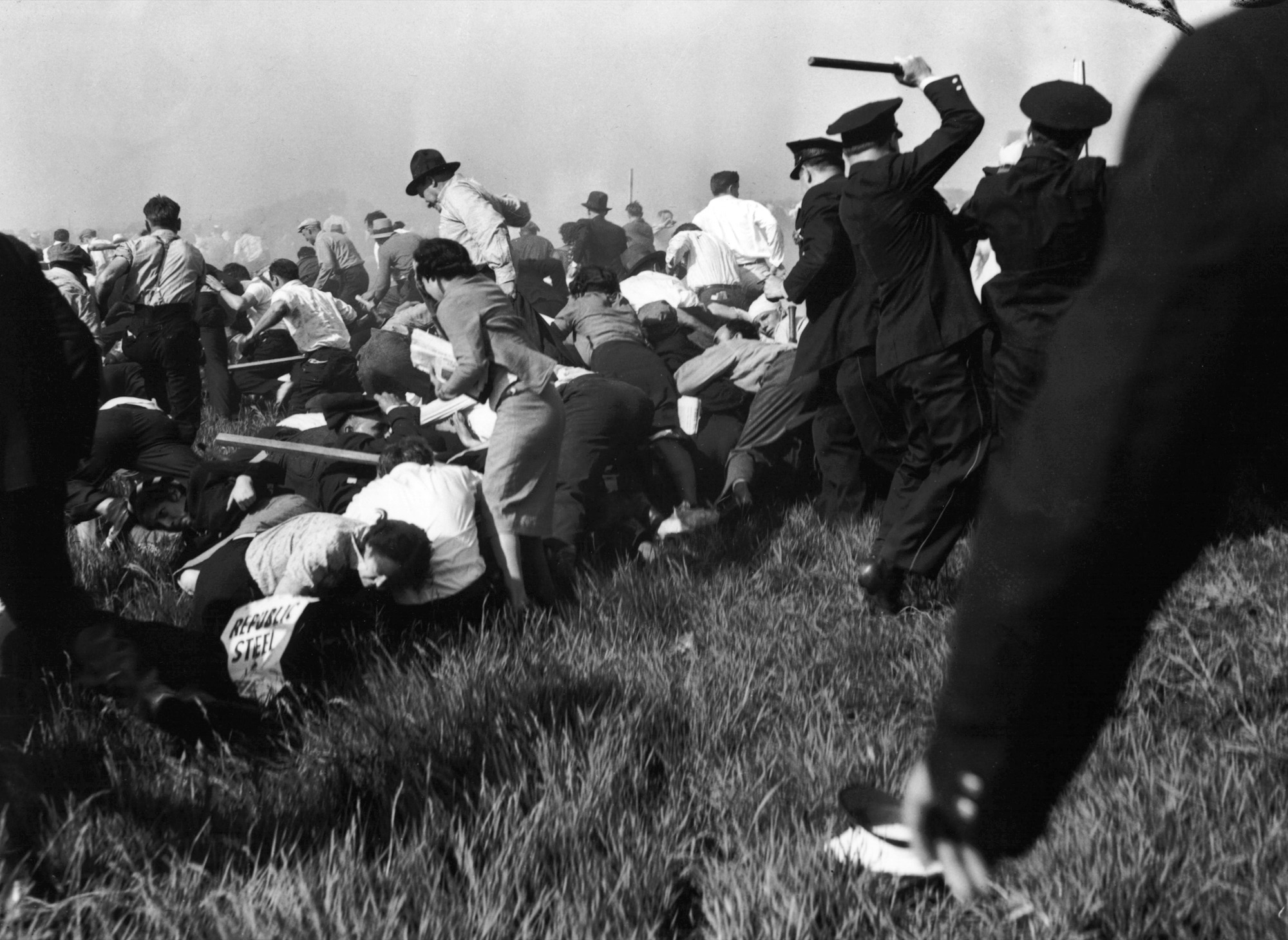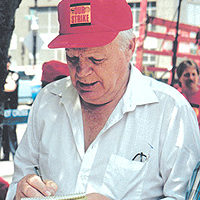
An earlier version of this article appeared in People’s Weekly World on May 31, 1997.
South Chicago, Memorial Day 1937: Mollie West was there with a group of high school seniors. Curtis Strong was there for the hell of it. Aaron Cohen was there because of the responsibilities assigned to him by the Communist Party.
“There” was the field fronting the Republic Steel plant in South Chicago, site of the Memorial Day Massacre of May 30, 1937.
It was the first warm day of spring. Hundreds of steelworkers, on strike against the “Little Steel” companies and backed by hundreds of supporters, some dressed in their Sunday best, had come to assert the right of the Steel Workers Organizing Committee (SWOC) to establish a picket line at the gate of the Republic Steel plant.
The line was never established. Before day’s end, they would be attacked by an army of gun-toting, stick-wielding Chicago cops. Ten men would be dead or mortally wounded, countless others severely beaten and many more temporarily blinded by tear gas.
Mollie was walking near the front of the group when Chicago’s finest opened fire with tear gas and pistols. “I started to run and fell down. Several others stumbled on top of me. It wasn’t very comfortable,” Mollie said in a telephone interview from Chicago. “But it may have saved my life. And it certainly kept me from being beaten with those riot sticks the cops were using.”
By the time Mollie came up for air, the worst was over. “It was unbelievable what I saw,” she said. “The place looked like a battlefield.” And she saw—or felt—something else: “I looked around to see a policeman holding his gun against my back. ‘Get off the field,’ he ordered, ‘or I’ll shoot you.’”

Several people came to her rescue and carried her to the first aid station at Sam’s Place, the watering hole that SWOC had rented as headquarters during the strike against the nation’s second-tier steelmakers.
Several doctors had responded to the call for public support. “They never imagined that they would need to turn it into a field hospital,” Mollie said. “But they did—just like in M*A*S*H.”
Curtis hadn’t planned on doing anything that day. He was working at the Gary Works of U.S. Steel and was an active SWOC member of what is now Local 1014 of the Steelworkers union. “I thought, why should I go? Shortly after General Motors capitulated to the Auto Workers union, U.S. Steel signed a contract with SWOC.”
But ever one to seek adventure, Curtis decided to go, “I thought—what the hell, why not?” he said when reached at his home in Gary. “What started as a lark became one of the most damnable experiences in my life.”
Curtis thought the first shots were meant to scare people. “I just knew that no one, not even Chicago’s notoriously anti-union police, would open fire on peaceful demonstrators who were demanding the right to put up a picket line at the Republic plant.”
But he soon found out how mistaken he was. “A guy about six feet away from me was hit and I started to run—and damn fast. I had set state track records when I was in high school.”
This article was part of the 2019 People’s World series: 100 Years of the Communist Party USA. Read the other articles published in the series.
Aaron Cohen had been a coal miner in southern Illinois and a leader in the reform movement of the United Mine Workers of America. As such, he earned the wrath of one Van A. Bittner, UMWA district director, whose goons once beat Aaron within an inch of his life.
But the heat of the class struggle can melt old relationships and forge new ones—and such was the case with Aaron Cohen and Van A. Bittner. By the time SWOC launched its drive to organize the steel industry, Bittner was running the show in Illinois and Cohen, then 28 years old, was a member of the Communist Party leadership in Chicago.
Shortly after setting up shop, Bittner invited Aaron and Bill Gebert, head of Illinois CP, to a meeting where he asked Aaron to find SWOC organizers among the various nationality groups and to help get favorable coverage of the campaign in the foreign-language press.
“It was a bit frosty at first,” Aaron remembers, “Bittner didn’t quite know how to deal with me. But I made the first move. I stuck out my hand and said something like, ‘We’re in this together, Van,’ and that was it.”
Aaron, who now lives in the San Francisco Bay Area, described the Memorial Day event as—at least in the beginning—a “jolly kind of affair. There was a holiday spirit. Guys were walking with their girlfriends. Some brought their families and picnic lunches. There was a baseball game and things for the kids to do.”
The strike began at 11 p.m. on May 26 and police had prevented the union from establishing a picket line at the Republic plant. “So we decided that the whole bunch would go down and set up a mass picket line. After all, Mayor Kelly said SWOC had the right to picket,” Aaron said.
Aaron, too, couldn’t believe what was happening. “But when Alfred Causey, who was standing less than arm’s length from me, fell with four bullets in his back, I became a believer.” Aaron’s voice hardened when he added: “There was Causey laying there dead—and they were still beating him.”
When the group—“at least 1,000 strong” according to George Patterson, who led the demonstration—neared Republic property, they were met by police lined up for about a quarter of a mile “protecting” the mill.
“For once, we had as many pickets as there were police,” Patterson said in his oral history of the massacre. “I went up to Police Commander Kilroy who was reading from a document. ‘I ask you in the name of the people of the State of Illinois to disperse,’ he read and dropped the paper to his side with a flourish.”
There was no verbal command, Patterson remembered. “When Kilroy lowered the paper, all hell broke loose. Bullets were flying, gas was flying, and then the clubbing.”
When Patterson stopped running, he looked at the carnage—at the young boy limping by, bleeding from a bullet wound in his heel, at men and women lying on the ground, some dead, others mortally wounded.
Patterson said he “learned about death” on the prairie before the Republic plant. “It doesn’t take long to know when a man falls forward on his face that he’s been killed, he’s dead, he doesn’t move anymore.”
Police may have been able to cover up the massacre had it not been for Orlando Lippert, a news cameraman for the Paramount Newsreel division and his motion picture camera.
Within seconds—“fewer than seven,” Lippert told a Senate investigating committee—after the assault began, he had his camera grinding away, eventually shooting several magazines of film which he sent to New York.
Paramount executives withheld the film, labeling it “restrictive negatives. Clips and printing of this material absolutely forbidden.”
However, the film was subpoenaed by Sen. Robert La Follette’s subcommittee of the Senate Education and Labor Committee and shown to a closed-door meeting that included Commander Kilroy, Patterson, and several reporters, some of whom wrote stories of the events depicted in the film.
A short clip of the film shot by Paramount cameraman Orlando Lippert, originally hidden from the public. | Illinois Labor History Society
Republic Steel’s Tom Girdler was the lead dog in the employer’s sleigh team that not only provoked the strike but made plans to drown it in blood in a holy war to prevent “the Communists” from taking over. And they meant business.
The La Follette hearings, which began on July 2, did more than expose the Memorial Day events. Committee investigators found that Republic was the largest buyer of tear and sickening gas in the country. Republic’s private arsenal was stocked with 552 revolvers, 64 rifles, 245 shotguns, and 83,000 rounds of ammunition. The other companies had similar arms caches.

In his autobiography, Len De-Caux, first editor of CIO News, described the Little Steel Strike as a “murderous class war.” In addition to the Memorial Day massacre in Chicago:
— Strikers were gassed, clubbed, and shot in Youngstown, Massillon, and Cleveland, bringing the total killed to 18.
— Governors, mayors, sheriffs, and police were suborned against SWOC and the CIO, sometimes with hard cash.
— The Mohawk Valley Formula, with its “citizens’ committees,” back-to-work movements, and other strike-breaking techniques was applied with vigor.
— “Friends of labor” in public office betrayed SWOC, as witnessed by Franklin D. Roosevelt’s “curse on both your houses” remark at a press conference.
Although the Little Steel Strike ended with only Inland signing an agreement, it has earned a place in the annals of the great battles of the American working class.
In 1937—as they had been in the Great Strike of 1919—steelworkers were in the vanguard of the class struggle.












Comments